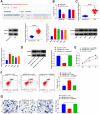Interfered long non-coding RNA HELLPAR or up-regulated microRNA-448 inhibits nasopharyngeal carcinoma progression via suppression of ADAM10
- PMID: 40397191
- PMCID: PMC12095706
- DOI: 10.1007/s12672-025-02565-5
Interfered long non-coding RNA HELLPAR or up-regulated microRNA-448 inhibits nasopharyngeal carcinoma progression via suppression of ADAM10
Abstract
Objective: Nasopharyngeal carcinoma (NPC) is a highly invasive malignancy with poor prognosis, necessitating further exploration of its molecular mechanisms. While HELLP-associated long non-coding RNA (HELLPAR), microRNA-448 (miR-448), and a disintegrin and metalloprotease 10 (ADAM10) have been implicated in other malignancies, their regulatory interplay and functional roles in NPC remain unclear. This study aimed to investigate the role of HELLPAR in NPC progression through its interaction with miR-448 and ADAM10.
Methods: Cancerous and adjacent non-cancerous tissues were collected from 53 NPC patients admitted to our hospital between 1st January 2018 and 1st January 2020. Transcript levels of HELLPAR, miR-448, and ADAM10 were measured using quantitative real-time PCR (RT-qPCR), while the protein expression levels of ADAM10 were assessed by Western blotting. Long-term survival data were analyzed to assess the correlation between HELLPAR expression and patient prognosis. The binding interactions of HELLPAR/miR-448 and miR-448/ADAM10 were predicted and experimentally validated. Overexpression and knockdown constructs for HELLPAR, miR-448, and ADAM10 were transfected into NPC cells to assess their effects on proliferation, invasion, and apoptosis.
Results: HELLPAR and ADAM10 were significantly upregulated at both the RNA and protein levels in NPC tissues and cells, while miR-448 was notably downregulated. Suppression of HELLPAR inhibited NPC cell proliferation and invasion while promoting apoptosis. Mechanistically, HELLPAR functioned as a competitive endogenous RNA (ceRNA) by binding to miR-448, thereby downregulating its RNA expression. Overexpression of miR-448 counteracted the tumor-promoting effects of HELLPAR. Additionally, miR-448 directly targeted and suppressed ADAM10. Overexpression of ADAM10 reversed the inhibitory effects of miR-448 on NPC cell proliferation and invasion.
Conclusion: The HELLPAR/miR-448/ADAM10 axis plays a critical role in NPC progression. Suppressing HELLPAR expression enhances miR-448 activity, which in turn downregulates ADAM10 at both RNA and protein levels, leading to reduced NPC cell proliferation and invasion while promoting apoptosis.
Keywords: A disintegrin and metalloprotease 10; Apoptosis; Invasion; Long non-coding RNA HELLPAR; MicroRNA-448; Nasopharyngeal carcinoma; Proliferation.
© 2025. The Author(s).
Conflict of interest statement
Declarations. Ethics approval and consent to participate: The study conformed to the principles expressed in the Declaration of Helsinki and was approved by the Institutional Review Board of Zhangjiagang Hospital Affiliated to Soochow University (Zhang Jiagang First Peoples Hospital). All patients provided written informed consent.Ethics approval and consent to participate. Competing interests: The authors declare no competing interests.
Figures





Similar articles
-
Long non-coding RNA PTPRG-AS1/microRNA-124-3p regulates radiosensitivity of nasopharyngeal carcinoma via the LIM Homeobox 2-dependent Notch pathway through competitive endogenous RNA mechanism.Bioengineered. 2022 Apr;13(4):8208-8225. doi: 10.1080/21655979.2022.2037364. Bioengineered. 2022. PMID: 35300558 Free PMC article.
-
Down-regulated long non-coding RNA LHFPL3 antisense RNA 1 inhibits the radiotherapy resistance of nasopharyngeal carcinoma via modulating microRNA-143-5p/homeobox A6 axis.Bioengineered. 2022 Mar;13(3):5421-5433. doi: 10.1080/21655979.2021.2024386. Bioengineered. 2022. PMID: 35176945 Free PMC article.
-
MicroRNA-185 inhibits cell proliferation while promoting apoptosis and autophagy through negative regulation of TGF-β1/mTOR axis and HOXC6 in nasopharyngeal carcinoma.Cancer Biomark. 2018;23(1):107-123. doi: 10.3233/CBM-181459. Cancer Biomark. 2018. Retraction in: Cancer Biomark. 2022;34(4):695. doi: 10.3233/CBM-220951. PMID: 29991129 Retracted.
-
Function of AXL and molecular mechanisms in regulation of nasopharyngeal carcinoma.Zhong Nan Da Xue Xue Bao Yi Xue Ban. 2022 Jun 28;47(6):685-697. doi: 10.11817/j.issn.1672-7347.2022.210786. Zhong Nan Da Xue Xue Bao Yi Xue Ban. 2022. PMID: 35837768 Free PMC article. Chinese, English.
-
Long noncoding RNA long intergenic non-protein-coding RNA 173 contributes to nasopharyngeal carcinoma progression by regulating microRNA-765/Gremlin 1 pathway.Hum Exp Toxicol. 2023 Jan-Dec;42:9603271231172921. doi: 10.1177/09603271231172921. Hum Exp Toxicol. 2023. PMID: 37365917
References
-
- Wotman M, et al. The prognostic role of programmed death-ligand 1 in nasopharyngeal carcinoma. Laryngoscope. 2020;130(11):2598–606. - PubMed
-
- Wu Q, et al. Cost-effectiveness analysis of gemcitabine plus cisplatin versus docetaxel, cisplatin and fluorouracil for induction chemotherapy of locoregionally advanced nasopharyngeal carcinoma. Oral Oncol. 2020;103: 104588. - PubMed
-
- Yu JY, et al. Quantitative analysis of DCE-MRI and RESOLVE-DWI for differentiating nasopharyngeal carcinoma from nasopharyngeal lymphoid hyperplasia. J Med Syst. 2020;44(4):75. - PubMed
-
- Alterio D, et al. Mixed-beam approach in locally advanced nasopharyngeal carcinoma: IMRT followed by proton therapy boost versus IMRT-only. Evaluation of toxicity and efficacy. Acta Oncol. 2020;59(5):541–8. - PubMed
LinkOut - more resources
Full Text Sources
